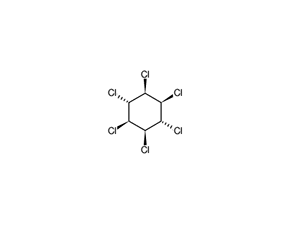
Lindane
CAS No. 58-89-9
Lindane( —— )
Catalog No. M19510 CAS No. 58-89-9
An organochlorine insecticide that has been used as a pediculicide and a scabicide.
Purity : >98% (HPLC)
 COA
COA
 Datasheet
Datasheet
 HNMR
HNMR
 HPLC
HPLC
 MSDS
MSDS
 Handing Instructions
Handing Instructions
| Size | Price / USD | Stock | Quantity |
| 100MG | Get Quote | Get Quote |


|
| 200MG | Get Quote | Get Quote |


|
| 500MG | Get Quote | Get Quote |


|
| 1G | Get Quote | Get Quote |


|
Biological Information
-
Product NameLindane
-
NoteResearch use only, not for human use.
-
Brief DescriptionAn organochlorine insecticide that has been used as a pediculicide and a scabicide.
-
DescriptionAn organochlorine insecticide that has been used as a pediculicide and a scabicide. Lindane has been banned in California United Kingdom Australia and many western countries due to concerns about neurotoxicity and adverse effects on the environment. In Canada Lindane is not recommmended as a first-line therapy due to reports of resistance neurotoxicity and bone marrow suppression but has been approved by the FDA as a second-line therapy for topical treatment of pediculosis capitis (head lice) pediculosis pubis (pubic lice) or scabies in patients greater than two years of age who cannot tolerate or have failed first-line treatment. Lindane is still allowed for pharmaceutical use until 2015.
-
In Vitro——
-
In Vivo——
-
Synonyms——
-
PathwayOthers
-
TargetOther Targets
-
RecptorGABAR| GLR
-
Research AreaInflammation/Immunology
-
IndicationLice And?Scabies
Chemical Information
-
CAS Number58-89-9
-
Formula Weight290.83
-
Molecular FormulaC6H6Cl6
-
Purity>98% (HPLC)
-
SolubilityDMSO:43 mg/mL
-
SMILESC1(C(C(C(C(C1Cl)Cl)Cl)Cl)Cl)Cl
-
Chemical Name123456-hexachlorocyclohexane
Shipping & Storage Information
-
Storage(-20℃)
-
ShippingWith Ice Pack
-
Stability≥ 2 years
Reference
1.Anand M et al. Drug Chem Toxicol. 1998 21(1):35-46.
molnova catalog



related products
-
Schisphenin E
Schisphenin E is a natural product for research related to life sciences.
-
Carnidazole
Carnidazole, an antiprotozoal drug of the nitroimidazole class, is used in veterinary medicine.
-
Secretin (28-54), hu...
Secretin (28-54), human, which acts on human secretin receptors, is a 27-amino acid residue C-terminally amidated peptide, .



 Cart
Cart
 sales@molnova.com
sales@molnova.com


